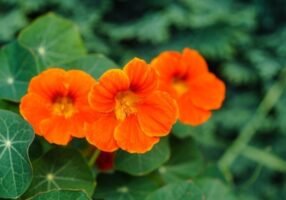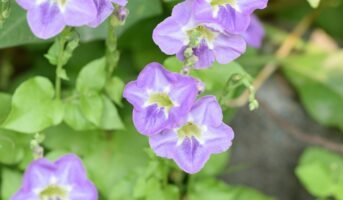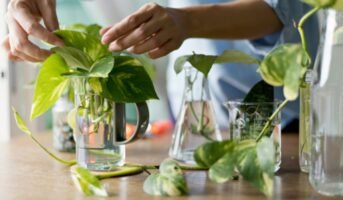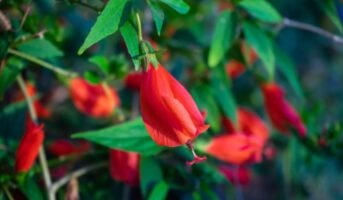What is Hedychium coronarium?
The Hedychium coronarium is a perennial garden staple in the south. When nothing else is blooming in late summer or early fall, this plant will add a splash of tropical colour to your garden.
Although they may look like lilies, the Hedychium coronarium plants are actually related to the culinary spice ginger root. However, unlike other flowers, Hedychium coronarium cannot be consumed. You can cultivate Hedychium Coronarium because their flowers are beautiful.
The graceful, orchid-like flowers of the ginger lily have earned the common name “butterfly ginger.” They are beautiful when arranged in a vase. An entire week’s worth of fragrant air can be enjoyed from a single vase of Hedychium coronarium.
Hedychium coronarium is a great addition to a garden for pollinators because butterflies love to drink the nectar from them.

Source: Pinterest
See also: Jasmine and its benefits
Hedychium coronarium: Key facts
| Common name | Butterfly ginger, butter lily, ginger lilies |
| Botanical name | Hedychium coronarium |
| Family | Zingiberaceae |
| Sunlight | Full sun, partial sun |
| Height | 24 to 150 inches |
| Water | Medium |
| Maintenance | Medium |
Hedychium coronarium: Features
Hedychium coronarium is a robust and attractive plant that can grow upto 6 feet tall in a container. The lance-shaped, sharp-pointed leaves of the Hedychium Coronarium plant range in size from 8 to 24 inches in length and 2 to 5 inches in width, and they are placed in two tidy ranks along the length of the stem. Midway through summer and into autumn, the stalks are crowned with long clusters of 6-12 inches in length of incredibly fragrant white blooms that resemble butterflies. In time, the Hedychium Coronarium blossoms will be replaced by a display of seed pods bursting with vibrant crimson seeds. There is a wide range of possible flower colours, including yellow, peach, white, and orange. You might compare the sweet aroma of Hedychium Coronarium to that of honeysuckle.
Hedychium coronarium growth tips
- In early spring, you can sow Hedychium seeds outside.
- Add just a thin layer of topsoil to protect the Hedychium Coronarium seed.
- The Hedychium family, of which the ginger lily is a part, prefers full sun and excellent drainage. They thrive in damp environments. To grow Hedychium coronarium from seeds indoors, you need a lot of humus. The Hedychium Coronarium seedlings should be ready to move into the garden about two months before the last spring frost or just after the last frost.
- Before planting Hedychium seeds, soak them for two hours in warm water. It takes three to four weeks for seeds to germinate when stored at 70 to 75 degrees Fahrenheit.
- After the Hedychium seedling has reached 60 to 80 cm, it can be planted in the garden.
Hedychium coronarium: Maintenance
Feeding and watering
- In hot, dry summers, the Hedychium Coronarium plant needs frequent watering. Soil damage can occur if it is allowed to dry out completely.
- If your soil isn’t naturally rich in nutrients and organic matter, you’ll need to add some before planting and again throughout the growing season to keep these plants happy. When necessary, apply a nutrient-rich organic compost or fertiliser to the plants.
Soil and transplanting
Soil should be organically rich, moist, and well-drained in addition to retaining water. Alkaline soil is undesirable.
Hedychium coronarium plants do well after being transplanted. Transplant the cuttings into permanent, partially shaded locations.
Pests and diseases
The sap in the Hedychium Coronarium leaves is a favourite food for aphids, scale insects, whiteflies, and mealybugs. The rhizomes, stalks, leaves, and flowers are all harmed by beetles. Use neem oil on the smaller insects. Large ones need to be picked up by hand and dunked into a bucket of water with some detergent added.
Hedychium care
- After blooming of Hedychium Coronarium has finished, prune the plant back to the ground.
- In cold climates, the rhizomes of perennial plants must be brought indoors to overwinter.
- At the end of winter, you can propagate additional Hedychium plants by dividing the rhizomes (carefully ensuring that each new section contains an eye).

Source: Pinterest
What are the benefits in Hedychium coronarium?
- The essential oil from the flowers of the Hedychium Coronarium species and others in the same genus is highly valued because it is used to make expensive perfumes.
- A Hedychium Coronarium root extract is used as a skin conditioner, tonic, and masking agent in commercial cosmetic products. The dried and powdered plant is used as a skin conditioner in commercial cosmetic preparations.
- The Hedychium Coronarium root contains 1.7% essential oil that is used for medicinal purposes.
Medicinal
- Hedychium Coronarium seeds have aromatic, carminative, and stomachic properties. The anti-inflammatory, stimulating, and restorative effects of the root are all well-documented.
- High-temperature fevers are treated by using the ground rhizome. Chest and arm pain can be relieved using a decoction.
- Essential oil extracted from the Hedychium Coronarium’s roots is carminative and has deworming uses.
- Tonsillitis can be treated by gargling a decoction made from the lower part of the stem or by chewing on a piece of the stem.
- The dried, powdered rhizomes can be used as an antiseptic.
- Ginger lily rootstalk is used to treat liver problems, indigestion, and poor circulation caused by thickened blood. It is also used to treat bronchitis.
Hedychium coronarium: Toxicity
Hedychium Coronarium poses no serious threat to humans or animals. The rhizomes of the Hedychium Coronarium can be eaten and hence it has not direct toxic effect on human beings and pets.
FAQs
Can Hedychium coronarium be consumed?
The rhizomes of this plant can be eaten.
How is Hedychium coronarium put to use?
The rhizome of butterfly ginger is used to treat headaches, lancinating pain, and contusion and is regarded as an anti-inflammatory.
Housing News Desk is the news desk of leading online real estate portal, Housing.com. Housing News Desk focuses on a variety of topics such as real estate laws, taxes, current news, property trends, home loans, rentals, décor, green homes, home improvement, etc. The main objective of the news desk, is to cover the real estate sector from the perspective of providing information that is useful to the end-user.
Facebook: https://www.facebook.com/housing.com/
Twitter: https://twitter.com/Housing
Email: [email protected]











